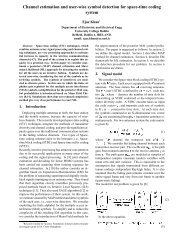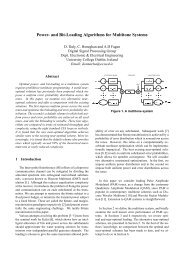Maximum likelihood detection of MIMO system using second order ...
Maximum likelihood detection of MIMO system using second order ...
Maximum likelihood detection of MIMO system using second order ...
You also want an ePaper? Increase the reach of your titles
YUMPU automatically turns print PDFs into web optimized ePapers that Google loves.
A¨+'WWWM+=W CM6MWby C¢' - A: - ; renaming , we see that such an Y' K¡ £¢< :¥¤ © ¤L:Y MSat most equalsQ¡ 1 CC (9)In <strong>order</strong> to minimize the last expression, we convert MAX-CUT problem into following quadratic problemThis minimum is approximately% as shown in [4].7790"¡§¦SK¡ £¢ K¡ £$013254¦678/8¥9 A ; A4. SIGNAL MODELWe consider BPSK case. We assume a discrete time block fadingmultiple antenna channel model D with transmit and receiveantennas, also we assume that the receiver has perfect channelknowledge. The received signal at an instant isA ¡IC ; A; A non-convex quadratic constraint problem is given byK¡ %¢& K¡ %$6 N A (17)R¨HW+,+' 1+.-/-/- + 8 (18)W1 + = ' 1 + ¨3 +4£C 1 + = ' 1 + ¨3 +4£; C AAwhere ¨ .is a known channel matrix, and£ . '©¨ $" £ +(10)>is the i.i.d. zero mean white Gaussian noise with variance . Thefading coefficients are i.i.d. Gaussian with zero mean and unitvariance. Under the aforementioned assumptions, the ML criterionrequires us find$ . > :to C¨minimizesML <strong>detection</strong>.$ > :, where $ : 0 C 1 + 1 5, which. Now we develop SOCP method for the5. SOCP ML DECODERThe problem can be written (after neglecting constant term) aswhere and N '©¨' C¨6¡$ '$ . Since [ W < : Y : b$A$"KNMON A$ +(11)+: 'D$ : + < +(12)$are the diagonal entries in J, can be absorbed in the vector . ThusNwithout loss <strong>of</strong> generality, we can assume that all diagonal entries<strong>of</strong> are zeros. The above equation is equivalent towhere Ais <strong>of</strong> the formA6¡$ ' 8=F © [ W < : Y : b Y © ¥ N NA: CAAC (13)(14)Since this cost function is symmetric, C : ' 1 need not bemaintained explicitly. It can be shown that the MAX-CUT problemis equivalent to ML <strong>detection</strong> with BPSK [9]. As mentionedearlier that the MAX-CUT problem is NP-hard, therefore we willuse some relaxation scheme to find near optimum solution. In thisrespect, note that ; ' 1PC1! +; ' 1#" +;W1 + +;1 (15)RA ; A; 1 + A ¡IC ; A; C 1 (16) ; where is all zero vector except 1 position= at . MaximizingAA implies minimizing M subject toC AA where ' H > ¡¤£¦ + N A('H "*) AH "01?2;4¨678/8¥9set <strong>of</strong> real symmetric matrices. The above problem can be writtenasN5464¦P R¡ 'H "*) AH "$.234= . , ) H . and R H . . > ¡¤£6is the P8 + R¡>= (23)then the right hand side <strong>of</strong> the above equation alsoimplies the left hand side. A convex quadratic constraint can nowR¡4¡ C ( A ¡ (24)P8 +which are convex quadratic constraints. If' > ¡¤£¦ be easily transformed into <strong>second</strong> <strong>order</strong> cone constraints. To d<strong>of</strong>or P8 this, we decomposeD'D Afirst , where =.(>&?and 7is symmetric and positive semidefinite. The constraint(25)' RF£87U¡ . Such a decomposition is always possible, asis equivalent toIt is known that anyR¡ A (26)A A R¡ (27)W +F£!A@+CB/.+(28)9ZE.




